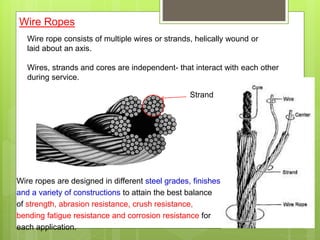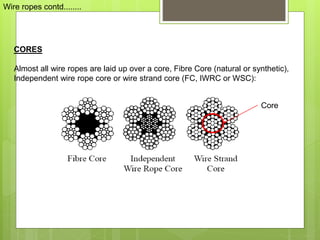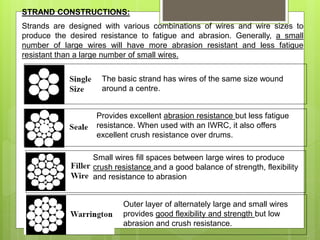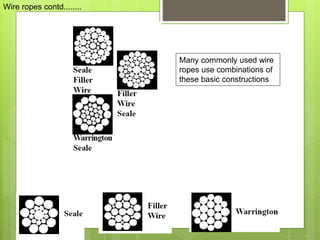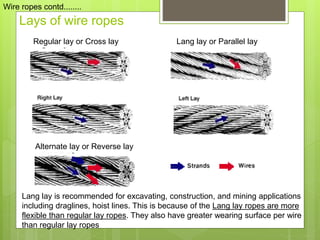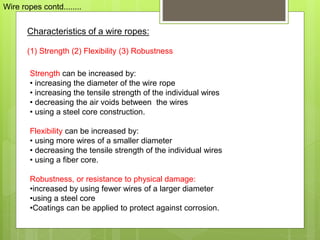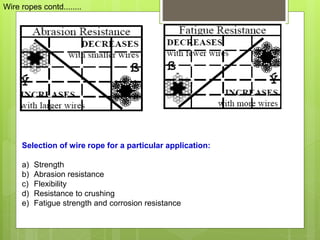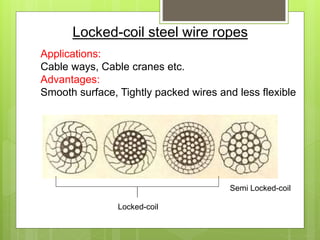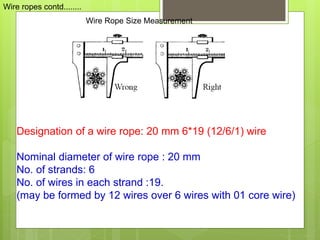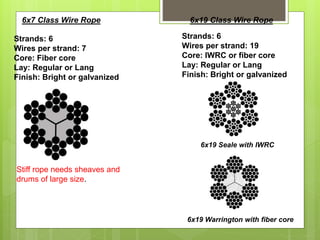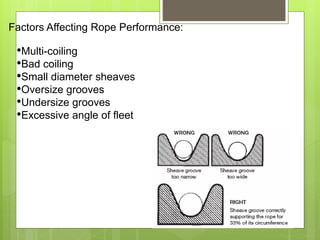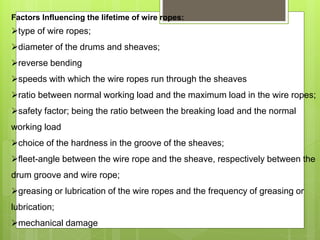Chapter 1 wire-rope Design.pptx
- 1. Wire Ropes Wire rope consists of multiple wires or strands, helically wound or laid about an axis. Wires, strands and cores are independent- that interact with each other during service. Wire ropes are designed in different steel grades, finishes and a variety of constructions to attain the best balance of strength, abrasion resistance, crush resistance, bending fatigue resistance and corrosion resistance for each application. Strand
- 2. CORES Almost all wire ropes are laid up over a core, Fibre Core (natural or synthetic), Independent wire rope core or wire strand core (FC, IWRC or WSC): Core Wire ropes contd........
- 3. STRAND CONSTRUCTIONS: Strands are designed with various combinations of wires and wire sizes to produce the desired resistance to fatigue and abrasion. Generally, a small number of large wires will have more abrasion resistant and less fatigue resistant than a large number of small wires. The basic strand has wires of the same size wound around a centre. Provides excellent abrasion resistance but less fatigue resistance. When used with an IWRC, it also offers excellent crush resistance over drums. Small wires fill spaces between large wires to produce crush resistance and a good balance of strength, flexibility and resistance to abrasion Outer layer of alternately large and small wires provides good flexibility and strength but low abrasion and crush resistance.
- 4. Many commonly used wire ropes use combinations of these basic constructions Wire ropes contd........
- 5. Wire ropes contd........ Lays of wire ropes Lang lay is recommended for excavating, construction, and mining applications including draglines, hoist lines. This is because of the Lang lay ropes are more flexible than regular lay ropes. They also have greater wearing surface per wire than regular lay ropes Regular lay or Cross lay Lang lay or Parallel lay Alternate lay or Reverse lay
- 6. Strength can be increased by: ŌĆó increasing the diameter of the wire rope ŌĆó increasing the tensile strength of the individual wires ŌĆó decreasing the air voids between the wires ŌĆó using a steel core construction. Flexibility can be increased by: ŌĆó using more wires of a smaller diameter ŌĆó decreasing the tensile strength of the individual wires ŌĆó using a fiber core. Robustness, or resistance to physical damage: ŌĆóincreased by using fewer wires of a larger diameter ŌĆóusing a steel core ŌĆóCoatings can be applied to protect against corrosion. Characteristics of a wire ropes: (1) Strength (2) Flexibility (3) Robustness Wire ropes contd........
- 7. Selection of wire rope for a particular application: a) Strength b) Abrasion resistance c) Flexibility d) Resistance to crushing e) Fatigue strength and corrosion resistance Wire ropes contd........
- 8. Locked-coil steel wire ropes Applications: Cable ways, Cable cranes etc. Advantages: Smooth surface, Tightly packed wires and less flexible Locked-coil Semi Locked-coil
- 9. Wire Rope Size Measurement Wire ropes contd........ Designation of a wire rope: 20 mm 6*19 (12/6/1) wire Nominal diameter of wire rope : 20 mm No. of strands: 6 No. of wires in each strand :19. (may be formed by 12 wires over 6 wires with 01 core wire)
- 10. 6x7 Class Wire Rope Strands: 6 Wires per strand: 7 Core: Fiber core Lay: Regular or Lang Finish: Bright or galvanized 6x19 Class Wire Rope Strands: 6 Wires per strand: 19 Core: IWRC or fiber core Lay: Regular or Lang Finish: Bright or galvanized 6x19 Warrington with fiber core 6x19 Seale with IWRC Stiff rope needs sheaves and drums of large size.
- 11. Fleet angle in wire rope: Range of Fleet angle for maximum efficiency and service: < 1.5o for smooth drum < 2o for grooved drum Large fleet angle: results in excessive rubbing of the rope against the flanges of the drum and the sheave groove, or crushing and abrasion of the rope on the drum.
- 12. Factors Affecting Rope Performance: ŌĆóMulti-coiling ŌĆóBad coiling ŌĆóSmall diameter sheaves ŌĆóOversize grooves ŌĆóUndersize grooves ŌĆóExcessive angle of fleet
- 13. Factors Influencing the lifetime of wire ropes: ’āśtype of wire ropes; ’āśdiameter of the drums and sheaves; ’āśreverse bending ’āśspeeds with which the wire ropes run through the sheaves ’āśratio between normal working load and the maximum load in the wire ropes; ’āśsafety factor; being the ratio between the breaking load and the normal working load ’āśchoice of the hardness in the groove of the sheaves; ’āśfleet-angle between the wire rope and the sheave, respectively between the drum groove and wire rope; ’āśgreasing or lubrication of the wire ropes and the frequency of greasing or lubrication; ’āśmechanical damage
